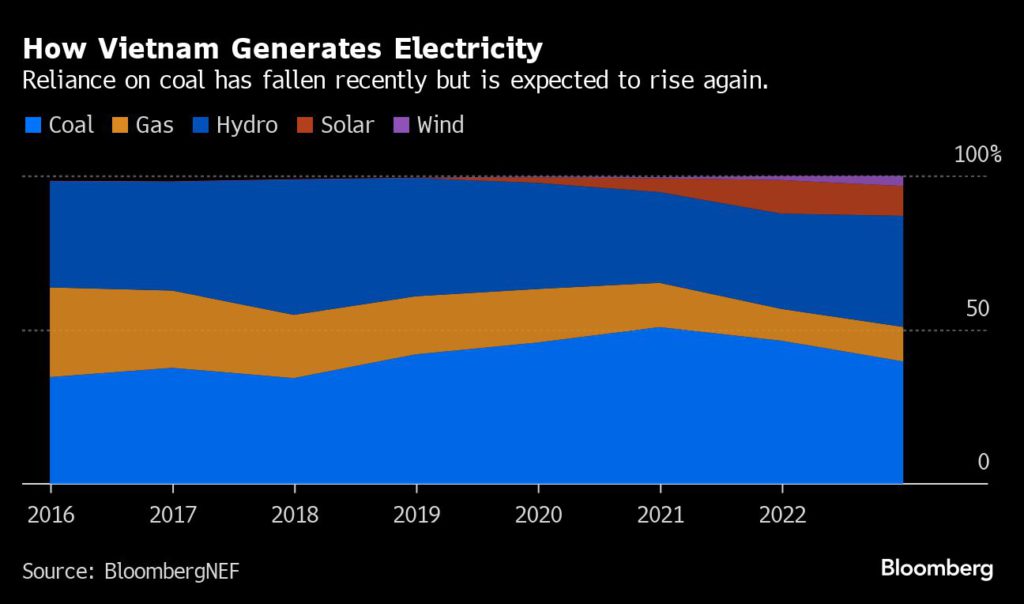News
There’s a way to quit coal without wrecking jobs and communities 2
Bloomberg News | December 7, 2023 | 1:25 pm
One of the LVA’s first tasks was to support the laid-off Hazelwood workers, almost all of whom ended up either with early retirement packages, placements in another local facility, or roles in the long process of decommissioning the mine.
It also became a champion for a slew of local projects, including a new performing arts center and a A$57 million geothermally heated aquatic center. The spending demonstrated investment, not abandonment, and softened community attitudes toward an agency that ultimately represented economic upheaval.
The LVA also began to develop relationships with renewable energy developers like Macquarie-backed Corio Generation, and Elanora Offshore, a five-member consortium that includes CLP’s EnergyAustralia and Royal Boskalis Westminster NV. There are now more dozens of large projects underway in Gippsland, worth about $55 billion in planned capital expenditure.
In general, these don’t require as many workers as coal mines and plants. But demand will be high for at least 15 years, estimates Charles Rattray, chief executive officer of Star of the South, a Victoria-based company that applied for one of the off-shore wind concessions.
“You have thousands of construction jobs” to build the projects, he said. “And there’s ancillary work in catering, accommodation, transport, the local supply chain.”
The LVA’s 2022 transition roadmap reflects more than 2,000 community meetings, Buckingham points out, and the work of a 48-person steering committee. “A successful transition for us is built from the ground up,” he said.
When Australia’s Labor Party won its first majority in nine years in 2022, it set out to reverse the previous administration’s entrenched denial of climate change and to shore up weakened ties with Southeast Asia. The clean energy transition is now listed as a “ pressing priority” of Australia’s $1.24 billion regional development aid. The country has committed $105 million to support sustainable economic growth in Vietnam.
The government also sponsored the Vietnamese delegation’s tour. Australia’s climate policies are far from ground-breaking, but it’s ahead of its regional neighbors.
“There’s high demand for learning from Australia’s experience,” said Thang, the academic. The Vietnamese wanted to know about the practicalities, policy instruments and technology, he said.
They spent a week in lectures at the Australian National University in Canberra and a week on site visits, including to the Latrobe Valley. The Vietnamese government declined Bloomberg Green’s requests for comment. Buckingham said their session was so animated they worked through the lunch break. “They were absolutely staggered by the age of our plants,” he said.

Coal is Vietnam’s single largest source of electricity and will continue to grow, the government says. At least six plants are set to come online by the end of the decade as the middle class expands and companies set up factories there.
That means it’s too early to think about taking coal plants off line or planning for the roughly 200,000 jobs at risk, said John Rockhold, chairman of the power and energy working group for the Vietnam Business Forum. At the same time, the country has set a 2050 net-zero goal. The country has already become a refuge for solar panel manufacturers eager to avoid the US tariffs on Chinese equipment.
“The government’s policy is: Let’s get our own renewable industry up and running,” Rockhold said. “We have the rare earths, we have the capabilities. Maybe we should slow down and build our own.”
This kind of long-term planning isn’t the most radical idea, but until recently, the coal industry — and its powerful allies — successfully argued there was no need, that climate change was overblown and its causes indeterminate. Net-zero commitments, with their timelines and interim benchmarks, force a longer view. They can also help shift the narrative from disappearing jobs to the new roles being created, as US President Joe Biden did in promoting the Inflation Reduction Act, a stimulus bill plowing billions of dollars into green technologies.
“You can’t just stand there and say, ‘Shut power stations,’” said Farmer, who after years of unpaid activism started in 2021 working as a community organizer for Friends of the Earth. “You just can’t take things away from people without offering solutions.”
For now, that means letting coal fires burn longer than the market — or the planet — can really tolerate. Rather than suffer another hasty closure, Australia has struck agreements to keep Gippsland’s remaining power stations open. Vietnam plans to experiment with so-called clean coal practices, which marginally reduce CO2 emissions. Among other trade-offs, those kinds of policies can distort the market for clean energy, discouraging investment just when it’s most needed.
In return, communities get a chance to survive the upheaval, maybe even to thrive. “People are rightly very proud of having provided electricity for Victoria for the last 100 years,” Wolfe said. “I think we’ve known for some time that what we’ve been doing is not great, that there’s better, cleaner ways to do it.”
“We have an opportunity to build an entirely new workforce, and that’s what I’m excited about.”
(By Janet Paskin)
RELATED NEWS
- O+ Tower Project Showcases Our Production Prowess 2025-02-20
- Guangdong Aluminum Association and Moscow University Business School visited Gua 2024-12-12
- Guangdong Aluminium Association International Trade Co., Ltd. signed an overseas 2024-11-21
- Guangdong Aluminum Association International Trade Co., Ltd. Participates in the 2024-11-15
- Simplified Approach to Spandrel Area Treatment in Curtain Wall Glazing 2024-10-25
CATEGORIES
LATEST NEWS
CONTACT US
Contact: Manager:Miss Jasmien
Phone: +8618825429836
E-mail: info@gdaa-cn.com
Whatsapp:+8618825429836
Add: Headquarter:No.8,Yixian Road,GDAA Mansion,Guangfo Zhicheng, Dali Town,Foshan,Guangdong.China
